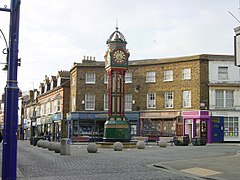| Sheerness | |
|---|---|
 Sheerness clock tower | |
Location within Kent | |
| Population | 13,249 (2021 census)[1] |
| OS grid reference | TQ919749 |
| • London | 37 miles (60 km) W |
| District | |
| Shire county | |
| Region | |
| Country | England |
| Sovereign state | United Kingdom |
| Post town | SHEERNESS |
| Postcode district | ME12 |
| Dialling code | 01795 |
| Police | Kent |
| Fire | Kent |
| Ambulance | South East Coast |
| UK Parliament | |
Sheerness (/ʃɪərˈnɛs/) is a port town and civil parish[2][3] beside the mouth of the River Medway on the north-west corner of the Isle of Sheppey in north Kent, England. With a population of 13,249, it is the second largest town on the island after the nearby town of Minster which has a population of 16,738.
Sheerness began as a fort built in the 16th century to protect the River Medway from naval invasion. In 1665 plans were first laid by the Navy Board for Sheerness Dockyard, a facility where warships might be provisioned and repaired. The site was favoured by Samuel Pepys, then Clerk of the Acts of the navy, for shipbuilding over Chatham inland.[4] After the raid on the Medway in 1667, the older fortification was strengthened; in 1669 a Royal Navy dockyard was established in the town, where warships were stocked and repaired until its closure in 1960.
Beginning with the construction of a pier and a promenade in the 19th century, Sheerness acquired the added attractions of a seaside resort. Industry retains its important place in the town and the Port of Sheerness is one of the United Kingdom's leading car and fresh produce importers. The town is the site of one of the UK's first co-operative societies and also of the world's first multi-storey buildings with a rigid metal frame.
- ^ "Sheerness". citypopulation.de. Retrieved 1 August 2024.
- ^ "Sheerness". Mapit. Archived from the original on 19 December 2019. Retrieved 19 December 2019.
- ^ "Sheerness Town Council Precept" (PDF). Swale Borough Council. Archived (PDF) from the original on 23 March 2020. Retrieved 19 December 2019.
- ^ "Friday 18 August 1665". The Diary of Samuel Pepys. Archived from the original on 19 August 2008. Retrieved 19 August 2008.
